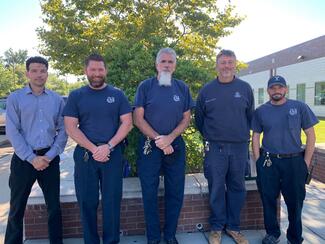We want to hear from you! Take the survey.
How do you use It’s Your Yale? How can it be improved? Answer for a chance to win Yale swag.
The Locksmiths of Central Campus – Fixing locks and cracking safes
September 17, 2021
At last count, there were more than 50,000 doors on Yale’s central campus, and they all have locks. Many are keyed; some have card readers. If a lock breaks, malfunctions, or is tampered with, Yale’s locksmiths respond with patience, skill, and sometimes a bit of muscle.
Currently, the Yale University locksmith team is responsible for rekeying rooms, floors, and buildings, lock repair or replacement, installing new locks, responding to lockouts, cutting new keys, and provide 24-hour emergency coverage. In addition to central campus and the athletic complexes, their work spans several satellite properties in Connecticut, including, the Gilder Boathouse, Gales Ferry Boathouse, and the McNay Family Sailing Center, to name a few. While card readers are becoming the norm, most campus doors are also key locked. This is done for safety and security reasons— if the card reader system goes down or if there is a power failure.
A day in the life
With the vast number of doors and locks around campus and beyond, this team of four keeps busy. On a recent day, they were out repairing a lock on a student’s room in one of the residential colleges and at several rooms in graduate housing; fixing the panic bar on an entryway door on York Street; installing electric strikes (card readers) in one of the professional schools and in Kirkland Hall on Hillhouse Avenue. And all this was done before lunch!
The most common issue Yale’s locksmiths encounter is a broken lock from wear and tear or tampering. A jammed lock is the hardest to fix and sometimes requires prying a door open. An unusual request involves cracking new to very old safes— there aren’t many left around campus but occasionally calls come in. Tools of the trade include a hammer, pliers, screwdrivers, small crowbar, and pick set—for the safes!
During the academic year, roof doors are regularly in need of service. The door at Sheffield-Sterling-Strathcona Hall (SSS) that provides access to the roof holds the unofficial record for most repairs. Even with this increased need for repair of more peculiar doors, the highest priority fixes, not surprisingly, are main entry and exterior doors to resolve security issues.
“One of our main concerns is, of course, keeping the students and staff safe no matter what time of day,” said John Devaney, locksmith.
Locks, springs, and spindles
Across Yale’s campus, lock mechanisms themselves can range from brand new to more than 100 years old. Some locks on the more elaborate doors and gates were forged by blacksmiths from Samuel Yellin Metalworkers out of Philadelphia, Pennsylvania, in the 1920s. Other older locks and hardware came from the Sargent Manufacturing Company, now known as Sargent Assa Abloy, located in New Haven. If needed, Yale’s locksmiths can make springs and spindles in-house that are used in many of these custom and standard repairs. Often, they will save parts from broken locks for reuse.
“Sometimes, with the older locks, they have fewer parts, so are easier to fix,” said Jason Schwartz, locksmith. “If we can’t get a part, we work with the machine shop team, who can fabricate something for us. Many of the real old locks are more ornamental; we have to get creative to fix them unless it becomes a security risk. Then we have to replace them with something new.”
When a new Yale building goes up, this team is responsible for installing the key system, including cores, springs, pins, and cutting the keys. Also, they deliver the new keys to the building manager, who must sign for them as part of an overall tracking and safety system.
The biggest changes in the last 15 or so years are electronics and card readers.  Marc Fanelli, Jeremy Walker, John Devaney, James Limosani & Jason Schwartz.
Marc Fanelli, Jeremy Walker, John Devaney, James Limosani & Jason Schwartz.
“Everything is being integrated; exterior doors have prox card readers as opposed to a key entry,” said Jeremy Walker, locksmith. “With a card reader, it is easier to issue new cards and track movement. When a call comes in involving an issue with a card reader mechanism, the team works closely with Yale Security and the vendor to get it fixed.”
The COVID-19 pandemic created additional work for the team, including adding locks to some common areas. Also, they had to lubricate many doors that hadn’t been opened in over a year. “It’s not good to have things sit unused for so long. September is usually busy, but this year with so many returning to campus, it’s been extra hectic,” said Jeremy.
Special thanks to:
- John Devaney, Yale locksmith with 33 years of service (and a famous beard)
- James Limosani, Yale locksmith with 24 years of service
- Jason Schwartz, Yale locksmith with 16 years of service
- Jeremy Walker, Yale locksmith with 20 years of service
Meeting the team – Note from the author
The team gathered in the Lockshop at 344 Winchester Avenue for a group interview and photo. They are a friendly, jovial group, but are also helpful and willing to answer questions about their work and experiences. Like many other people I interview for Inside Facilities, they possess a vast knowledge of the campus, its buildings, history, and people and have many interesting stories to tell.
In addition to all sharing this trade, they are animal lovers, all owning one or more rescue dogs and cats. Lisa M. Maloney, Internal Communications


